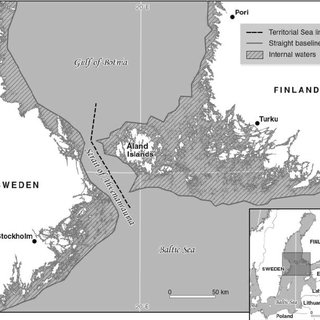The self-governing province of the Åland Islands lies off the southwest coast of Finland. Åland is an autonomous, demilitarised, Swedish-speaking region of Finland. Åland consists of more than 6,700 islands, but the current population of over 30,000 live on only 60 islands. Alan island has 1,580 km² area.
When it ratified the LOS Convention in 1996, Finland confirmed its declaration on signature in part that:
It is the understanding of the Government of Finland that the exception from the transit passage regime in straits provided for in article 35(c) of the Convention is applicable to the strait between Finland (the Åland Islands) and Sweden. Since in that strait the passage is regulated in part by a longstanding international convention in force, the present legal regime in that strait will remain unchanged after the entry into force of the Convention.
Sweden made a similar claim when signing and ratifying the LOS Convention. In claiming Åland’s Hav, the 16-mile wide entrance to the Gulf of Bothnia, as an exception to the transit passage regime, Sweden and Finland relied on the fact that passage in that strait is regulated, in part, by the 1921 Convention relating to the Non‑fortification and Neutralization of the Åland Islands. It should be noted that under article 4.II of this Convention, the territorial sea of the Åland Islands extends only “three marine miles” from the low-water line and in no case extends beyond the outer limits of the straight line segments set out in article 4.I of the Convention. The 1921 Convention is therefore not applicable to the remaining waters that form the international strait. The United States, which is not a party to this Convention, has never recognized this strait as falling within article 35(c) of the LOS Convention.

